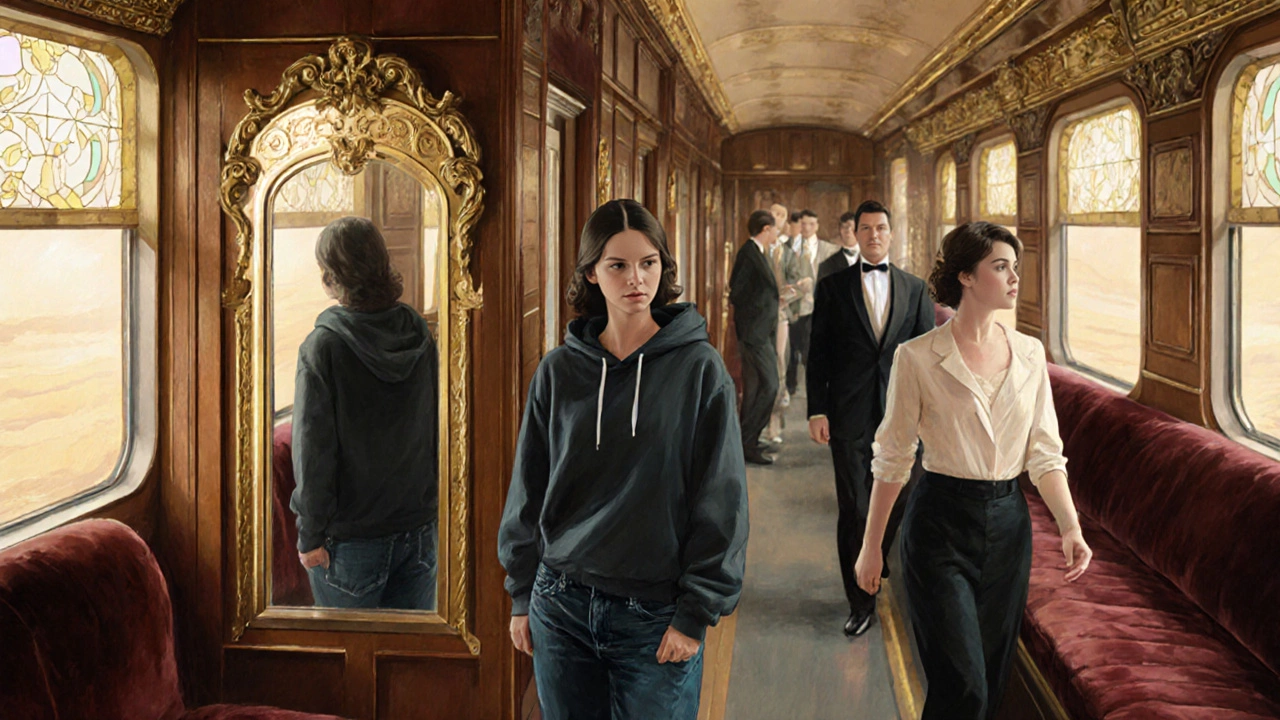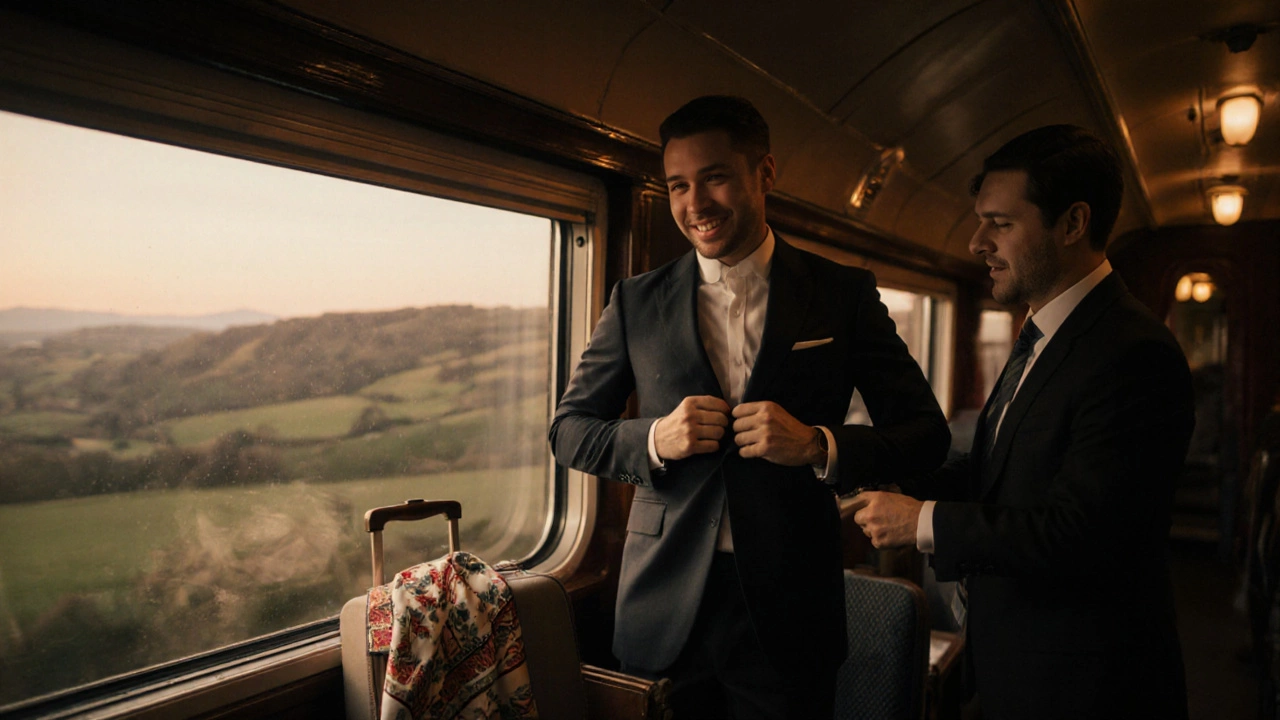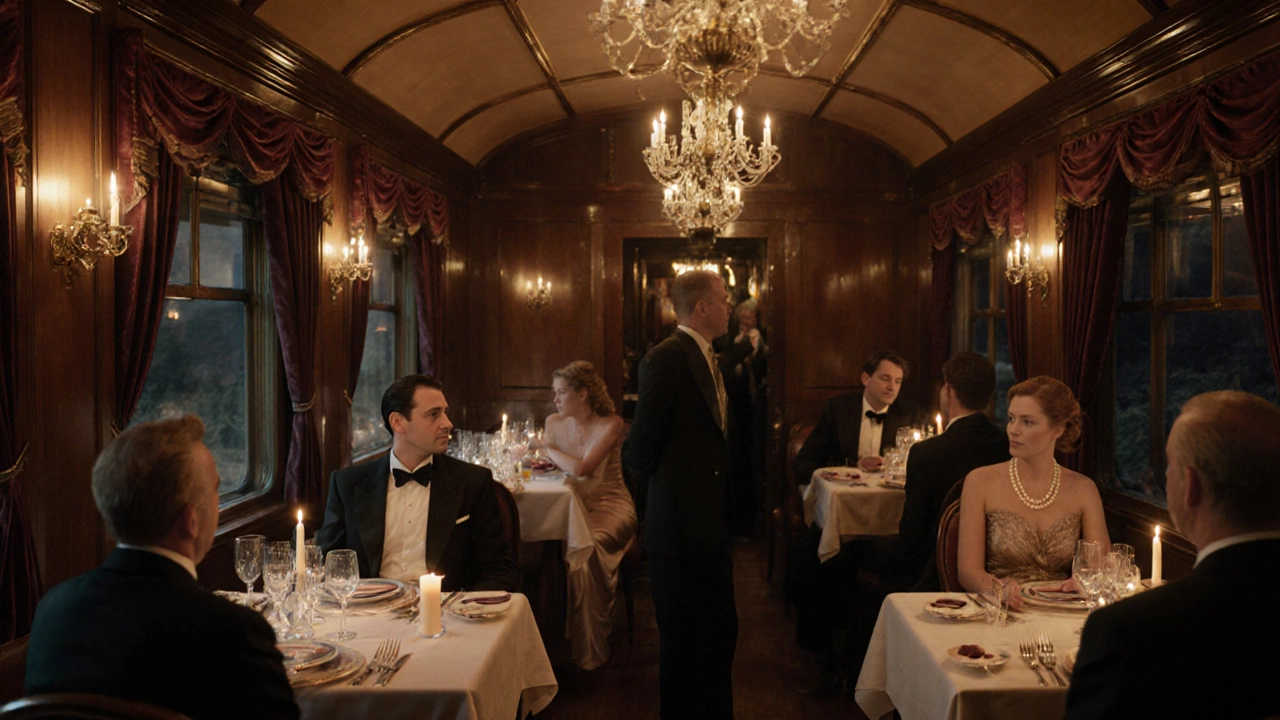Orient Express Dress Code Checker
Check Your Outfit for the Orient Express
Select your travel time and clothing choices to see if they match the luxury train's dress code requirements
Ever wondered if you can roll up to the Orient Express in jeans and a hoodie? You’re not alone. The question comes up every season-especially as more people start dreaming about luxury train travel. The answer isn’t simple. It’s not a strict no, but it’s not a casual yes either. The Orient Express isn’t a bus or a flight. It’s a moving palace. And how you dress? That’s part of the experience.
What the Orient Express Really Is
The Venice Simplon-Orient-Express isn’t just a train. It’s a piece of history. Launched in 1982 by Belmond, it’s a faithful recreation of the 1920s and 1930s golden age of rail travel. The carriages were originally built between 1926 and 1930, restored to their original elegance with polished wood, brass fittings, velvet drapes, and crystal chandeliers. The staff wear vintage-inspired uniforms. The dining cars serve multi-course meals on fine china. The atmosphere is curated, intentional, and deeply nostalgic.
This isn’t about showing off. It’s about stepping into a different time. People don’t just ride the train-they participate in a ritual. The dress code reflects that. It’s not about rules for rules’ sake. It’s about matching the setting.
What You’re Expected to Wear
There are three key moments during a journey: daytime, evening dinner, and private moments in your cabin. Each has its own unwritten standard.
Daytime: Think smart casual. Tailored trousers, blouses, knit sweaters, or well-fitted dresses. A linen shirt with chinos? Perfect. A pair of clean, dark jeans? Acceptable-if they’re not ripped, faded, or paired with sneakers. The goal is neat, thoughtful, and elegant. No flip-flops, no athletic wear, no tank tops.
Evening dinner: This is where the magic happens. The dining car is candlelit, the waiters are in white gloves, and the menu reads like a Michelin guide. Men are expected to wear a suit or a blazer with dress pants. Ties aren’t mandatory, but they’re common. Women wear cocktail dresses, elegant separates, or tailored jumpsuits. No jeans. No sneakers. No casual fabrics like denim or cotton jersey.
Why? Because dinner isn’t just eating. It’s theater. The food, the wine, the conversation-it’s all part of a performance. And your outfit? It’s your costume.
Why Jeans Don’t Fit (Even If They’re Dark)
Let’s be clear: it’s not that jeans are dirty or cheap. It’s that they belong to a different world. Denim was invented for laborers. It’s durable, functional, and meant to be worn hard. The Orient Express is the opposite. It’s about refinement, not utility.
Even the most expensive, black, slim-fit jeans still carry the DNA of blue-collar workwear. On a train where the carpets are hand-woven, the silverware is sterling, and the wine is poured by a sommelier, denim stands out-not because it’s bad, but because it’s out of place.
One passenger told me she wore jeans on the first day and felt like she was the only one who didn’t get the memo. She didn’t get stares, but she felt it. The silence around her table wasn’t cold-it was curious. Like she’d shown up to a symphony in flip-flops.

What to Pack Instead
You don’t need a whole new wardrobe. But you do need to think differently.
- For men: One blazer, two pairs of tailored trousers, three dress shirts, one pair of leather loafers, and a silk scarf or pocket square. A turtleneck under the blazer works for cooler evenings.
- For women: Two dresses (one longer, one shorter), a tailored blazer, a silk blouse, a pair of elegant flats or low heels, and a wrap or shawl for the train’s air-conditioned cabins.
- Both: A small evening clutch, a watch, and minimal jewelry. No loud logos. No oversized bags.
Pro tip: Pack a foldable garment bag. The cabins are small. You’ll thank yourself when you can hang your blazer instead of crumpling it in a suitcase.
What Happens If You Show Up in Jeans?
Nothing dramatic. You won’t be turned away. The staff are professionals. They won’t make you feel bad. But you’ll feel it.
You’ll notice how other guests glide past you in velvet and silk. You’ll hear the clink of crystal glasses and realize your jeans are the only thing in the room that doesn’t shimmer. You’ll wonder why you didn’t bring something better.
It’s not about judgment. It’s about alignment. The Orient Express isn’t trying to exclude anyone. It’s trying to preserve an experience. And that experience is built on details-like the weight of the linen, the cut of the collar, the silence between sips of wine.
Real Stories from the Tracks
A couple from Chicago booked their trip after watching a documentary. The wife, a fashion designer, brought six outfits. The husband, a software engineer, packed three pairs of jeans. On night two, he borrowed a blazer from the concierge. He said it was the first time in his life he felt like he was dressed for something bigger than himself.
Another guest, a 72-year-old retired professor from London, wore the same navy suit every night. He’d had it tailored in 1978. He didn’t need new clothes. He just needed to remember how to be present. He said the train brought him back to when he first met his wife-on a train from Paris to Vienna, in 1968.
These aren’t fashion stories. They’re human ones. The clothes are just the surface.

What About Other Luxury Trains?
The Orient Express is unique, but it’s not alone. The Maharajas’ Express in India, the Royal Scotsman in Scotland, and the Glacier Express in Switzerland all have their own dress codes.
On the Maharajas’ Express? Suits and saris are common. On the Royal Scotsman? Tweed jackets and wellington boots are the norm. In Switzerland? Smart outdoor wear works fine. Each train has its own culture. The Orient Express is the most formal.
If you’re planning multiple luxury train trips, treat each one like a different event. One might be a gala. Another might be a mountain hike in style. Don’t assume the rules are the same.
Final Rule: Dress for the Moment, Not the Mileage
You’re not paying for a ride. You’re paying for a memory. And memories stick because they’re felt, not just seen.
Jeans are fine for hiking, for running errands, for coffee with friends. But the Orient Express? That’s a night at the opera. A dinner with history. A journey through time.
So yes-you *can* wear jeans. But should you? Ask yourself this: When you look back at your photos in ten years, do you want to remember yourself in denim… or in something that made you feel like you belonged to something extraordinary?
What If You Can’t Afford New Clothes?
You don’t need to buy a whole new wardrobe. Borrow. Rent. Shop secondhand. Many luxury travel agencies offer garment rental services for their clients. A tailored blazer can be rented for $50 for the trip. A silk dress? Often under $100 for a week.
One woman rented a 1920s-inspired beaded dress from a vintage theater costumer. She said it felt like stepping into a movie. She didn’t need to own it. She just needed to wear it.
It’s not about cost. It’s about care.
